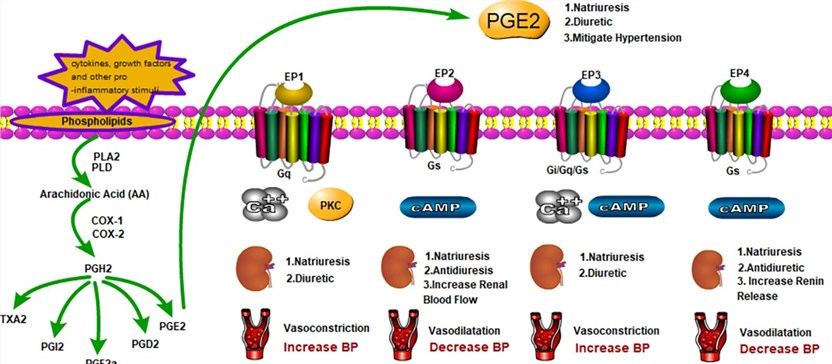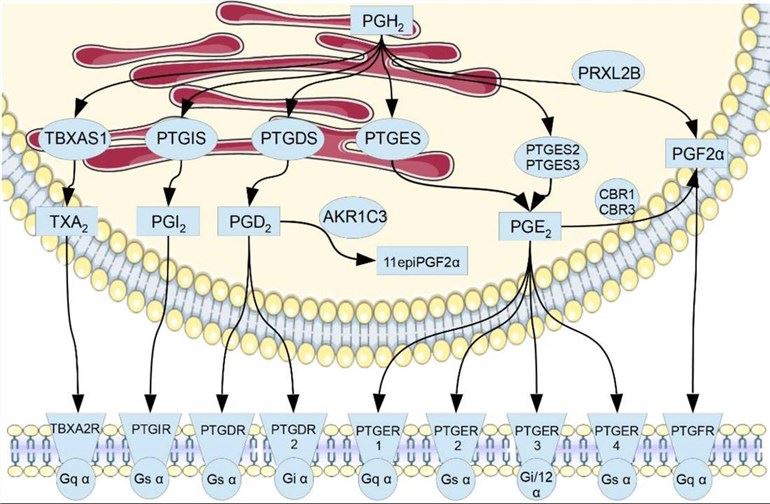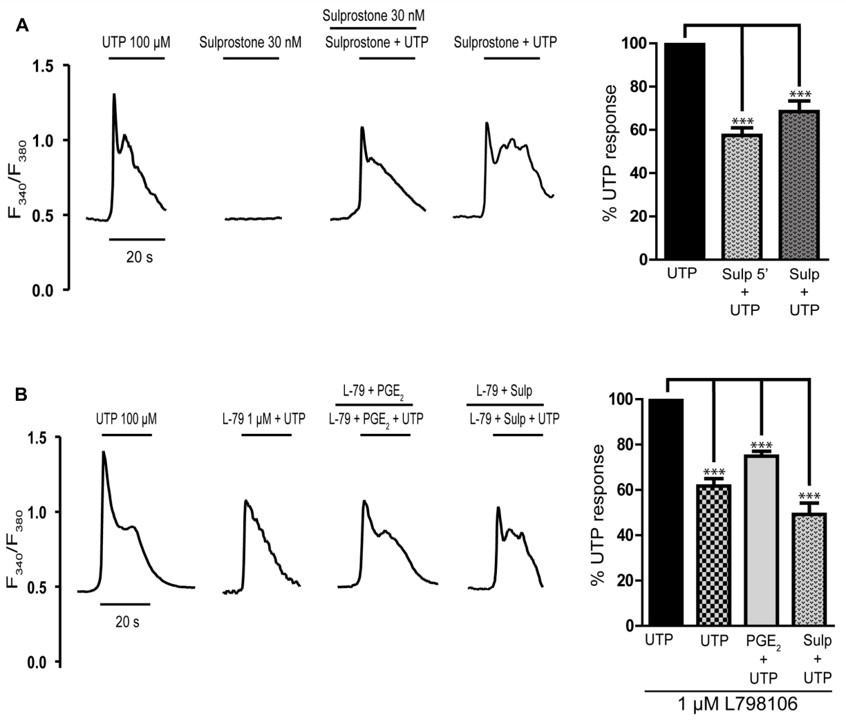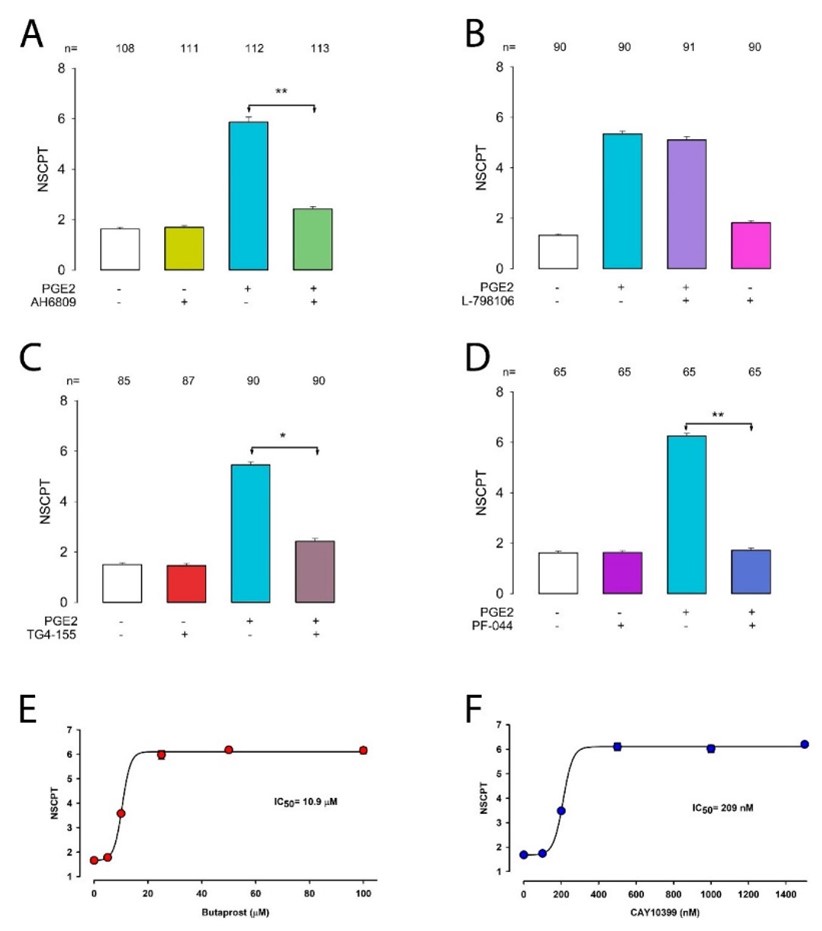Hi-Affi™ In Vitro Cell based Prostanoid Receptor Functional Assay Service
The Importance of Prostanoid Receptors
The prostanoid receptors (EP, FP, IP, TP, and DP ) are members of the rhodopsin-like GPCR family. Each receptor can bind to specific ligands and initiate distinct signal transduction pathways. They play a crucial role in the cardiovascular and immune processes, as well as in peripheral systems for sensations of pain. Currently, prostaglandin receptors with complex and diverse functions are gradually triggering an increasingly widespread research craze. Therefore, developing an in vitro cell-based prostanoid receptor functional assay service will be a valuable tool for drug development.
 Fig.1 The EPs' role in PGE2 production and related functions in fluid homeostasis and blood pressure.1
Fig.1 The EPs' role in PGE2 production and related functions in fluid homeostasis and blood pressure.1
The Principle of Hi-Affi™ In Vitro Cell-Based Prostanoid Receptor Functional Assay Service
To aid in advancing drug development, Creative Biolabs successfully developed an efficient and robust Hi-Affi™ in vitro cell-based prostanoid receptor functional assay service platform. We take advantage of the accumulation of second messengers as indicators of our Hi-Affi™ in vitro cell-based prostanoid receptor functional assay service to respond to the reactions of prostanoid receptors with ligands. With the help of this assay, the functions of the candidate samples or their regulation ability to prostanoid receptors can be fully examined. At Creative Biolabs, we provide a full range of related high-quality services to enable the ideal results for each customer.
 Fig.2 The signaling pathway of prostanoid receptors scheme.2
Fig.2 The signaling pathway of prostanoid receptors scheme.2
Our Advantages
- Cell Lines: multiple types; sustained stability; identified.
- Experiment System: equipped with advancing instruments and technologies; fast timeline; highly effective.
- Research Team: professional and experienced; competent.
- Service: one-stop customized services; high-quality; comprehensive.
Representative Data
Representative Data 1: Due to the fast production of cyclooxygenase 2, prostaglandin E2 (PGE2), an essential bioactive lipid, accumulates in response to tissue injury or inflammation. Depending on the cellular setting, PGE2 exerts pro- or anti-inflammatory activities by activating particular G-protein coupled EP receptors. These findings supported prior hypotheses that EP3 receptors were involved in this phenomenon. WB showed the presence of EP3 receptors, although tests using an antagonist for this receptor were equivocal. While this antagonist did not affect baseline calcium levels, it significantly reduced calcium responses to UTP by 40 percent.
 Fig.3 Modulation of UTP calcium responses by EP3 receptor ligands in rat cerebellar astrocytes.3
Fig.3 Modulation of UTP calcium responses by EP3 receptor ligands in rat cerebellar astrocytes.3
Representative Data 2: Since PGE2 may act via any of four different G-protein-coupled receptors (EP1, EP2, EP3, or EP4), this study aims to identify the specific receptor(s) responsible for mediating this reaction. Agonists and antagonists of EP receptors were tried for which would have the desired effect. Based on these findings, it seems that PGE2 enhances GJIC through EP1, EP2, or EP3, with EP2 being the receptor responsible for this effect rather than EP1 or EP3.
 Fig.4 The prostaglandin E2 receptor (EP2) mediates this increase in GJIC.4
Fig.4 The prostaglandin E2 receptor (EP2) mediates this increase in GJIC.4
Work with Creative Biolabs
To respond to global customers' valuable feedback and cater to the development of industrial, Creative Biolabs is substantially innovating technologies and services. During project execution, we prioritize delivering optimal outcomes to each customer by offering comprehensive, customized, and top-notch services.
If you want to know more about our Hi-Affi™ in vitro cell-based prostanoid receptor functional assay service, please feel free to contact us at your convenience. We cordially welcome your inquiry and anticipate to work with you.
References
-
Wang, Lu, et al. "Roles of EP receptors in the regulation of fluid balance and blood pressure." Frontiers in Endocrinology 13 (2022): 875425.
Distributed under Open Access License CC BY 4.0, without modification. -
Ershov, Pavel V., et al. "Prostanoid signaling in cancers: expression and regulation patterns of enzymes and receptors." Biology 11.4 (2022): 590.
Distributed under Open Access License CC BY 4.0, without modification. -
Paniagua-Herranz, Lucía, et al. "Prostaglandin E2 impairs P2Y2/P2Y4 receptor signaling in cerebellar astrocytes via EP3 receptors." Frontiers in Pharmacology 8 (2017): 937.
Distributed under Open Access License CC BY 4.0, without modification. -
Ogazon del Toro, Alejandro, et al. "Prostaglandin E2 Enhances Gap Junctional Intercellular Communication in Clonal Epithelial Cells." International Journal of Molecular Sciences 22.11 (2021): 5813.
Distributed under Open Access License CC BY 4.0, without modification.
For Research Use Only.
